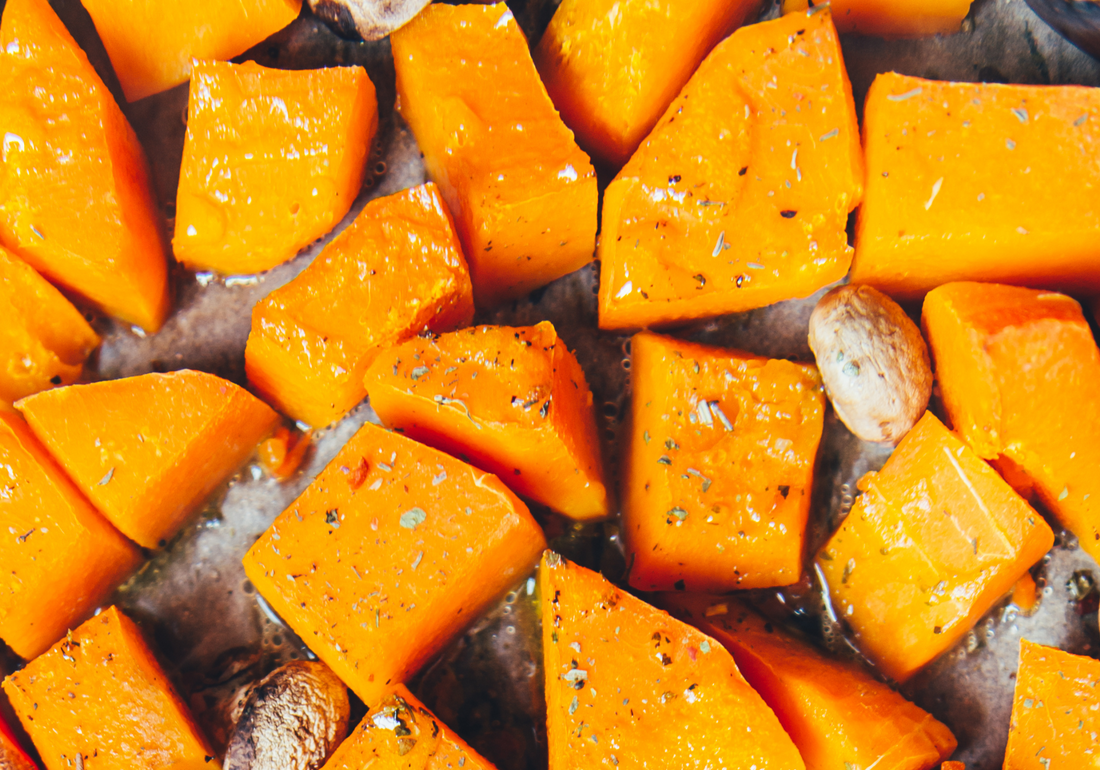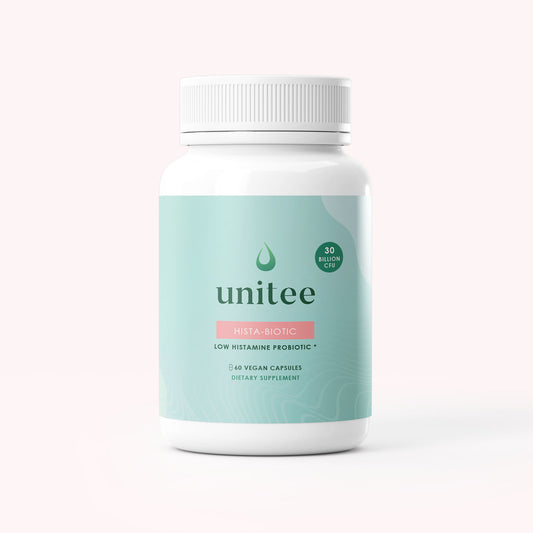Buddha bowls are in!
...and there's so much to love about them. They're a great way to pack small portions of a variety of nutritious foods into one dish. They're fresh, healthy and they taste so great with all of the tangy, zesty flavours you can add.
They sound amazing, don't they? Or does the thought of a Buddha bowl terrify you because of all of the high histamine foods they contain?
Although Buddha bowls are now in many restaurants and health food stores, when you’re dealing with a histamine intolerance, it’s like every ingredient that’s typically added to these amazing bowls, will cause your already high histamine levels to skyrocket.
Don’t worry! You don’t have to stick to eating boring old bland rice and chicken breasts for the rest of your days while you figure out what's causing your histamine intolerance. I have a real treat for you, and I bet you’re going to love this low histamine take on a typical buddha bowl. Not only is it packed full of great, healthy low-histamine ingredients, you’re going to love how it tastes, too.
So, if you're looking for a low histamine twist on this trending recipe, read it and eat it!
Bonus: it’s super easy to prep and make at home!
Histamine Intolerance Chicken Salad Buddha Bowl Recipe: Nutrition Facts
You already know that all of the go-to ingredients in a traditional Buddha Bowl like avocado, soy sauce, pickled cabbage (and pickled anything, really), along with certain nuts, seeds and lemon dressings are either histamine-containing or histamine-releasing (1). Fortunately for you, I've done all of the research behind the perfect substitutes!
That’s right. I’ve substituted each of these high histamine foods with other ingredients that match similar textures and flavours, so you won’t even miss them! In fact, I'd even go as far to say that our low histamine version is even more nutritious and tasty than the original!
Let's explore why...
Chicken and egg are healthy protein sources, complete with a full complement of the amino acids your body needs to build protein, hormones, enzymes and a host of other body functions.
But, keep in mind, these ingredients need to be fresh (2)!
Why? Because, proteins are especially high in histamine and other biogenic amines like tyramine and putricine. When the tissue begin to break down, which is what happens once the proteins begin to degrade over time, results in more histamine and other biogenic amine release into the foods. So, once the food has been cooked and cooled, it immediately begins to increase its histamine content which contributes to the reason leftover food increases histamine intolerance symptoms (3). The bottom line is when you're living with histamine intolerance, the fresher the food the better, and the sooner you eat it after cooking, the less likely it is to cause you symptoms.
Egg is often questioned on a low-histamine food plan, but I can assure you many people tolerate them. It's when the white is raw or partially cooked that causes the most trouble, as the raw white is quite high in histamine. On the other hand, a whole egg is usually well-tolerated and low in histamine when the white is thoroughly cooked. If you don’t tolerate eggs in general, feel free to leave it out of the recipe and add a little more chicken.
Roasted vegetables are so versatile! No longer are they a warm side to a winter’s dinner. Hot or cold, you can add them to your salad for a deliciously different flavor.
Now, before you turn your nose up at brussels sprouts, give the roasted variety a try. They’ll be crisp and salty after being in the oven and, paired with the sweetness of the roasted butternut squash, you can’t go wrong. Brussels sprouts also add a ton of nutrient density to the dish. They're high in vitamin C, which supports the immune system. For just half a cup, they also contain around 90% of your recommended daily intake of vitamin K, the essential blood clotting and bone health vitamin (4). Additionally, they're very low in carbohydrates and high in fiber, which support your efforts to keep your blood sugar in check.
Butternut squash is also a nutrient powerhouse. Just 1/2 a cup contains over 200% of your daily vitamin A requirement. Vitamin A is essential for immune function and in the maintenance of your heart and lungs as well as other vital organs (5). Butternut contains a variety of additional minerals and vitamins your body needs to function; a tasty multivitamin meal if you will! While some of you may think that it is a high carb food, the amount of fiber in butternut squash reduces the sugar spike you would otherwise get from the equivalent eaten in the form of simple carbohydrates. For this reason, I love to include low histamine butternut squash in many of my recipes.
Fresh ingredients that are low in histamine, like snow peas and carrots, add that extra little bit of texture to the bowl. They too are packed with fiber and vitamins, contributing to the overall health benefits of this tasty Buddha bowl.
What about the sauces that bring all of the Buddha bowl ingredients together? Soy sauce is usually it, isn't it?
But, not only is soy one the restricted histamine intolerance food list, it is also commonly gluten-containing, which for those of you with sensitive digestive system or food intolerances, it’s most definitely something you want to stay away from.
So, when you can't use soy sauce, vinegar, tahini, lemon or any other commercial sauce, what do you do?
I've got you!
Add my favorite low histamine salad dressing as a safe and tasty replacement for soy sauce and you'll have the best Buddha bowl you've ever tasted.
Finally, add a dash of green in the form of freshly chopped cilantro leaves and you’re all set. Cilantro has been suggested as being one of the healthiest herbs. It may support the body's elimination of heavy metals, reduce oxidative stress, lower blood sugar (6), support digestive health and even reduce the risk of urinary tract infections.
Now you have all of the inside info as to why this low histamine chicken salad bowl could stand up to any traditional Buddha bowl in flavor and health; all without any of those ingredients that could send your histamine levels soaring (7). Eating good, healthy food is entirely possible when you need to cut back on high histamine foods… and this salad bowl is just one of the ways we can prove it!
If you're still unsure of exactly what you should be eating and how your diet can help to reduce your symptoms, check out my low histamine food list, and my free guide on how to identify your food sensitivities!
Putting It All Together: Low-Histamine Chicken Salad Buddha Bowl Recipe
Serves: 1
Calories: 517
Carbohydrate: 49g
Protein: 20g
Fat: 24g
Ingredients:
- 1 small chicken breast, diced
- 1 hard boiled egg, halved (omit if you don't tolerate eggs)
- ½ cup roasted Brussels sprouts, halved
- ½ roasted butternut squash, cubed
- ½ cup fresh snow peas, chopped
- ½ cup carrots, grated
- 1 tbsp olive oil or low histamine salad dressing (I suggest my Herby Low Histamine Salad Dressing)
- 2 tablespoons fresh cilantro, chopped
Directions:
- Preheat the oven to 450 F.
- Cook the chicken in a saucepan on the stovetop over medium heat until the chicken is browned and the juices run clear. Set aside in the refrigerator to cool.
- Boil the egg in water for 10 minutes until completely hard. Set aside in the refrigerator to cool.
- Roast the Brussels sprouts and butternut squash in the oven, drizzled with a little olive oil and a pinch of salt for 30-45 minutes until browning and turning soft. Set aside in the refrigerator to cool.
- Once the chicken, egg and roast vegetables are cool, assemble your salad bowl. Arrange in sections in a bowl the chicken, Brussels sprouts, butternut squash, chopped snow peas, and grated carrots.
- Nestle the two egg halves into the ingredients in the bowl.
- Drizzle the olive oil or low histamine salad dressing across the top of the bowl.
- Sprinkle the cilantro over the top.
- Serve immediately and enjoy!
References:
- Sánchez-Pérez S, Comas-Basté O, Veciana-Nogués MT, Latorre-Moratalla ML, Vidal-Carou MC. Low-Histamine Diets: Is the Exclusion of Foods Justified by Their Histamine Content?. Nutrients. 2021;13(5):1395. Published 2021 Apr 21. doi:10.3390/nu13051395
- Ede G. Histamine Intolerance: why freshness matters. J Evol Heal. 2017;2(1):11.
- Durak-Dados A, Michalski M, Osek J. Histamine and Other Biogenic Amines in Food. J Vet Res. 2020;64(2):281-288. Published 2020 Apr 30. doi:10.2478/jvetres-2020-0029
- Booth SL. Vitamin K: food composition and dietary intakes. Food Nutr Res 2012;56.
- laner WS. Vitamin A and Provitamin A Carotenoids. In: Marriott BP, Birt DF, Stallings VA, Yates AA, eds. Present Knowledge in Nutrition. 11th ed. Cambridge, Massachusetts: Wiley-Blackwell; 2020:73-91.
- Aissaoui A, Zizi S, Israili ZH, Lyoussi B. Hypoglycemic and hypolipidemic effects of Coriandrum sativum L. in Meriones shawi rats. J Ethnopharmacol. 2011;137(1):652-661. doi:10.1016/j.jep.2011.06.019
- Maintz L, Novak N. Histamine and histamine intolerance. Am J Clin Nutr. 2007;85(5):1185–96.

Anita Tee
My name is Anita Tee. I'm a nutritional scientist who specializes in histamine intolerance. I hold a Master of Science in Personalized Nutrition and a Bachelor of Science in Human Biology and Psychology.
For the past ten years, I have used my experience in nutritional and medical health sciences to create a scientifically backed, natural approach to healthcare that relies 100% on evidence-based research.
As I previously suffered from - and overcame - histamine intolerance, my focus is to increase recognition and expand the available resources and protocols available for resolving this particular disorder. To date, I have helped over 4,000 individuals fully resolve or better manage their histamine intolerance symptoms.







